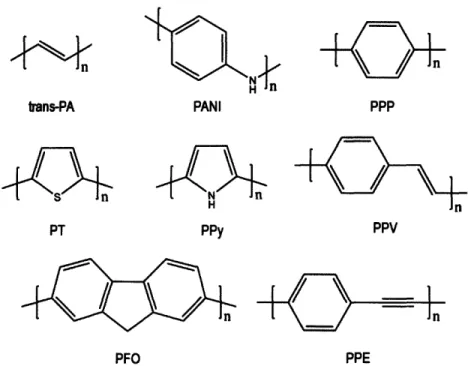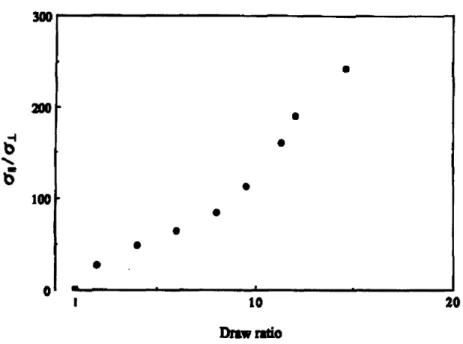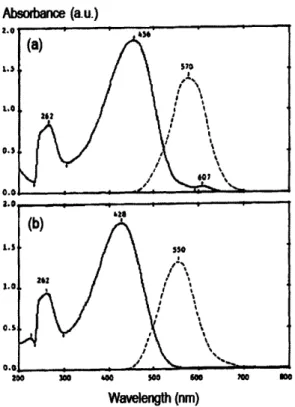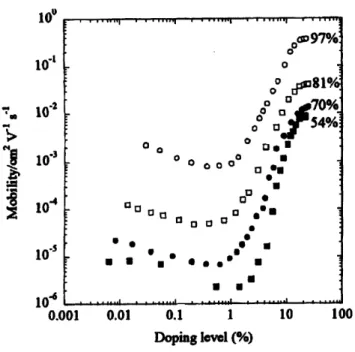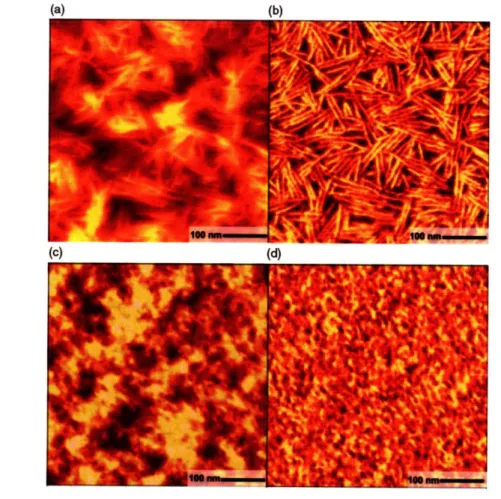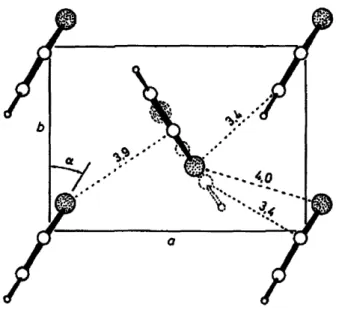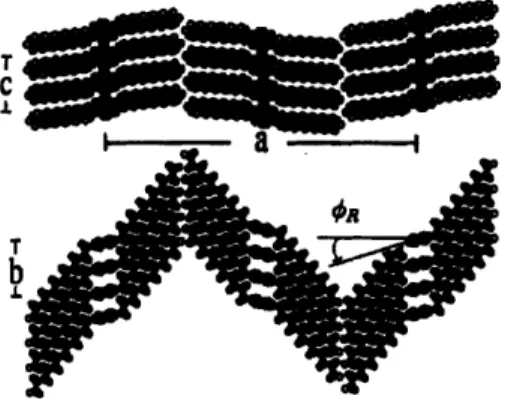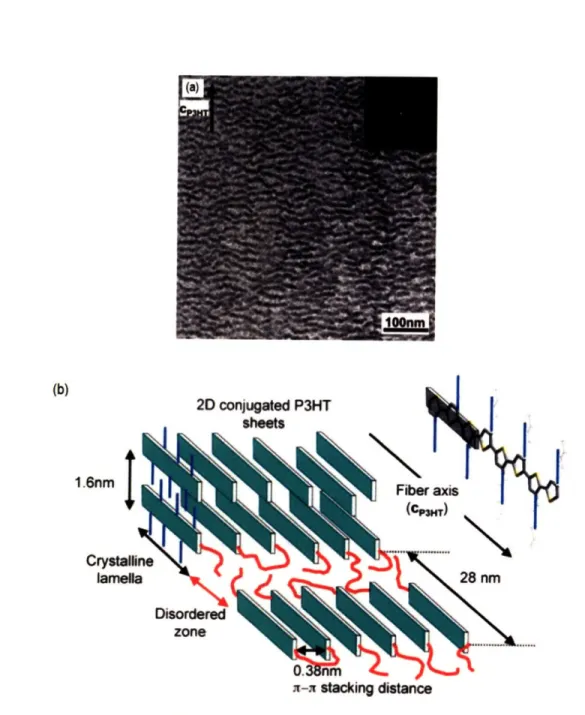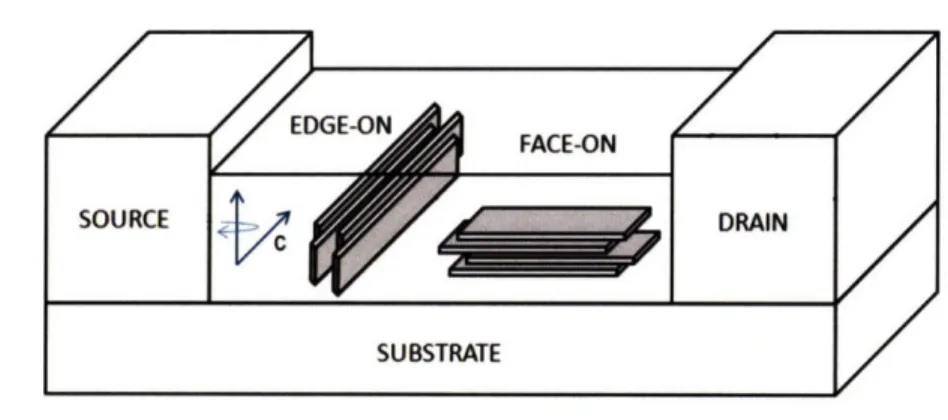A Conjugated Polymer Pla tic
Gel
MASSACHUSETTS INSTITUTE OF TECHNOLOGY
by
Daniel Alcazar Jorba
SEP 122008
LIBRARIES
SUBMITTED TO THE DEPARTMENT OF MATERIALS SCIENCE ANd
ENGINEERING IN PARTIAL FULFILLMENT OF THE REQUIREMENTS FOR THE DEGREE OF
MASTER OF SCIENCE IN MATERIALS SCIENCE AND ENGINEERING AT THE
MASSACHUSETTS INSTITUTE OF TECHNOLOGY SEPTEMBER 2008
© Massachusetts Institute of Technology 2008. All rights reserved.
A uthor ... : ... ... ... . .
Departme ~of Tateri s Science and Engineering
f/
/
August 28, 2008
C ertified by ...
.
...
...
...
...
Edwin L. Thomas
Head of the Department
Morris Cohen Professor of Materials Science and Engineering
Thesis Supervisor
Accepted by ... ... .. . . ,...
Samuel M. Allen
POSCO Professor of Physical Metallurgy
Chair, Departmental Committee on Graduate Students
A Conjugated Polymer Plastic Gel
by
Daniel Alcazar Jorba
Submitted to the Department of Materials Science and Engineering on August 28, 2008, in partial fulfillment of the requirements for the degree of
MASTER OF SCIENCE IN MATERIALS SCIENCE AND ENGINEERING
Abstract
We present a gel route to process highly oriented conjugated polymer films and fibers. The incorporation of hexafluoroisopropanol, a strong and stable dipolar group, to the polythiophene backbone enhances the solubility and especially, the hydrogen bond forming capabilities of the polymer. This functionalization enables the polymer to build up an isotropic self-supporting network structure based on a combination of polymer-polymer chain interactions and interchain hydrogen-bondings. These thermally reversible physical crosslinks incorporate plasticity in the conjugated polymer gel. The gel network can be melted and then transformed via mechanical deformation to form an anisotropic gel with the chains highly aligned along the tensile direction. The oriented gel morphology comprises a distribution of crystalline clusters in an overall swollen network. In these ordered regions, conjugated backbones are n-stacked with respect to each other neighbors. The mechanically induced structural rearrangement from an isotropic to an anisotropic conjugated polymer gel occurs when transitioning from the molten state to the gel state. This study highlights the versatility of incorporating plasticity in the design of conjugated polymer materials via a gel processing technology and its potential for applications.
Thesis Supervisor: Edwin L. Thomas
Acknowledgements
First, I would like to express my deepest gratitude to my research advisor Prof. Edwin Thomas for his enthusiastic support and mentoring, his insightful suggestions and his patience and care throughout the preparation of this thesis. Ned has been central in the development of my scientific ability, teaching me to think more critically and to approach research in a more effective manner.
This research project was possible thanks to the innovative polymer chemistry of Prof. Timothy Swager in Department of Chemistry at MIT. I would like to gratefully acknowledge Prof. Swager's great generosity in sharing his knowledge and resources. I am also very grateful to Prof. Samuel Allen for guiding my academic progress at MIT during the past two years.
I'd like to thank my teammates and collaborators, in particular Steven Kooi, Vahik Krikorian, Henry Koh, Joe Walish, Raf Mickiewicz, Ji-Hyun Jang, Wei Zhang and Rebekah Bjork for creating a stimulating and supportive environment. Special thanks go to Fei Wang for preparing the polymer at the center of this research and for her assistance during my time at the chemistry laboratory and to Scott Speakman for his help in the x-ray diffraction part of this work.
Finally, my deepest feelings are to my family, especially to my parents. They made many sacrifices to give me the best opportunities possible. I'll always be thankful to them for instilling values of a good education and hard work.
Contents
1 Introduction 13
1.1 Motivation 13
1.2 Thesis Overview 16
2 Background 19
2.1 Introduction to Conjugated Polymers 20
2.2 Morphology and Charge Transport in Polythiophenes 25
2.3 Engineering Chain Alignment in Conjugated Polymers 40
3 Gelation of Hexafluoroisopropanol Functionalized Polythiophene 51
3.1 Procedure 52
3.1.1 Materials 52
3.1.2 Gelation Protocol 55
3.1.3 Spectroscopy and Microscopy Techniques 58
3.2 Gelation Mechanism 59
3.3 Chapter Conclusions 66
4 Oriented Gel Films 67
4.1 Procedure 68
4.1.1 Film Processing 68
4.1.2 Characterization Techniques 71
4.2 Structure and Stability of Oriented Films 73
4.2.1 Light Microscopy 73
4.2.2 X-Ray Diffraction 76
4.2.3 Electron Imaging and Diffraction 78
5 Oriented Gel Fibers 85
5.1 Procedure 85
5.1.1 Fiber Processing 86
5.1.2 Light and Electron Microscopies 87
5.2 Structure of Drawn Fibers 89
5.2.1 Light Microscopy 89
5.2.2 Transmission Electron Microscopy 91
5.2 Chapter Conclusions 95
6 Conclusions and Future Directions 97
6.1 A Plastic Gel Route for Conjugated Polymers 98
6.2 Suggestions for Future Work 99
List of Figures
2-1 Chemical structures of important conjugated polymers 21
2-2 Charge storing configurations in trans-PA and PT 23
2-3 Anisotropy of the electrical conductivity 25
2-4 Regioregularity in polythiophenes 27
2-5 Impact of regioregularity on optical properties 29
2-6 Mobility dependence on degree of regioregularity and doping level 31
2-7 AFM of regioregular poly(3-hexylthiophene) thin films 33
2-8 Structure of the a-b plane orthogonal to the chain axis of PT 35
2-9 General structural arrangement proposed for P3AT 36
2-10 TEM of P3HT thin film grown by directional eutectic solidification 37
2-11 Edge-on and face-on orientations of conjugated backbones 39
2-12 Polarized light micrograph of a rubbing aligned P3HT thin film 42
2-13 Absorption spectra of a film prepared via a LB technique 44
2-14 Electron diffraction an oriented PPV film 48
3-1 Molecular structure of regiorandom HFIP-PT, methanol and water 52
3-2 Synthesis of HFIP-PT 53
3-3 Distinctive aromatic C-H 1H NMR signals in HFIP-PT 54
3-4 Procedure to induce exchange between THF and methanol 55
3-5 1H NMR (300MHz, CDC13) after 48h of solvents interdiffusion 57
3-6 Polarized light micrograph of a piece of HFIP-PT gel 60
3-7 FTIR spectra of representative drying series 62
3-8 FTIR spectra as a function of solvent interdiffusion time 64
3-9 Schematic of the H-bonding association at the crosslinking site 66
4-2 Typical surface profiles for the tapered gel oriented films 70
4-3 TEM and XRD optics 73
4-4 Optical anisotropy analysis of an HFIP-PT oriented gel film 74
4-5 Thermal stability of oriented gel films 76
4-6 XRD analysis of an HFIP-PT oriented gel film 77
4-7 TEM analysis of an HFIP-PT oriented gel film 79
4-8 Model of HFIP-PT oriented gels 81
5-1 Procedure followed to draw fibers 87
5-2 LM analysis of drawn fibers 90
5-3 PLM analysis of necked regions in an oriented gel fiber 91
5-4 TEM analysis of an HFIP-PT oriented gel fibers 92
5-5 Bright-field TEM micrographs of an oriented fiber 94
6-1 Chemical structures of oxalic acid and terephthalic acid 102 6-2 UV-VIS absorption and fluorescence emission spectra of HFIP-PT 104
List of Tables
3-1 Selected group frequencies for O-H and C-O vibrational modes
Chapter 1
Introduction
1.1
Motivation
As conjugated polymer materials become available for commercial applications, there is a clear need to understand and improve their processing characteristics. A variety of technologies have been suggested depending on the approach chosen to overcome the typical infusibility and low solubility of unsubstituted conjugated backbones. The incorporation of side chains has become a common strategy to make otherwise intractable backbones processable. In the case of crystallizable conjugated polymers, the nature of these lateral pendant groups influences polymer morphology, optical and charge transport properties.
Conjugated polymers are appropriate for applications driven by large area, flexibility and low-cost. Of the technologies promoted, solution processing turned out to be the technique of choice for thin film deposition due to its low-cost and high-speed.' Nevertheless there exist drawbacks that seem difficult to address as they are inherent to the physical characteristics of this process. Solution processing consists on transitioning from a dilute polymer solution to a solid film via solvent evaporation. This type of process is appropriate for amorphous flexible chain polymers such as poly(methyl methacrylate). However, the situation for crystalline polymers is more challenging. Although good uniformities are obtained with regard to film coverage and thickness using spin-coating or spray-coating, the finite length of the polymer chains and the multiplicity of nucleation events results in inhomogeneous polycrystalline morphologies and poor control over the alignment of chains. The situation becomes even more challenging for crystalline rigid-rod polymers. Moreover, in multilayer architectures the solvents used for one layer can affect previously applied layers and limit the flexibility in device design.
In certain applications, anisotropic electronic and optical properties are of interest. In these situations, morphologies with uniaxially oriented chains can take advantage of the intrinsic anisotropy of the conjugated system along the chain axis. Furthermore, in materials design for electronic devices, the temperature is a relevant factor due to the viscoelastic nature of polymers. In this context, we suggest an ideal structure consisting on a three-dimensional network with uniaxial orientation of the
conjugated backbones in a continuous single crystal-like morphology. Our starting point relies on the synergistic combination of polymer gelation with mechanical orientation as a beneficial interplay between intermolecular interactions and
ordering fields.2 As an example, the work by Thomas and Cohen demonstrated the
formation of a crystal-solvate phase between a molecularly stiff polymer and its solvent during the coagulation stage of fiber spinning resulting in high degree of
crystallinity and uniaxial alignment of the chains.3
This thesis constitutes an exploratory study of a novel gel processing route to incorporate plasticity in conjugated polymers. The polymer at the center of this research is a dipole functionalized polythiophene prepared by Professor Swager's group in Department of Chemistry at MIT. The chemical nature of the hexafluoroisopropanol (HFIP) pendant group results in a periodic incorporation of hydroxyl moieties along the backbone able to participate in strong hydrogen bonding associations. The approach followed is based on a two step strategy, first gelation of hexafluoroisopropanol functionalized polythiophene (HFIP-PT) with small polar protic molecules, essentially poor solvents/non-solvents. The gelation mechanism likely combines polymer-polymer chain interactions and interchain associations promoted by hydrogen bonding. Second, melting the gel network followed by mechanical processing into films and fibers with uniaxial orientation of the chains along the tensile direction.
1.2
Thesis Overview
The general framework of this study is presented in Chapter 2. Starting with an introductory overview on the semiconducting nature and charge transport properties of conjugated polymers, we then discuss solution processing of crystallizable regioregular polythiophenes with a particular emphasis on the relationship between structure, morphology and electronic properties. As a source of inspiration and to illustrate the actual need for this type of research, we review the major techniques proposed to date to engineer chain alignment in conjugated polymer materials.
In Chapter 3, we report the detailed procedure followed to prepare HFIP-PT gels. The gelation mechanism is analyzed by means of Fourier transform infrared spectroscopy. We suggest HFIP-PT is able to build up an isotropic self-supporting network structure based on a combination of chain-chain polymer interactions and interchain associations between HFIP pendant groups through hydrogen bonding with small polar protic molecules such as methanol and water.
The method to prepare the oriented gel films and the techniques used for structural analysis (light and electron microscopy and electron and x-ray diffraction) are presented in Chapter 4. The degree of in plane chain alignment is further quantified by dichroism analysis. Based on optical and diffraction analyses, we propose an oriented gel morphology consisting in an anisotropic distribution of paracrystalline clusters in an overall swollen network. In these ordered phases,
HFIP-PT chains are highly aligned and ai-stacked with respect to one another. The ability of the gel to attain highly anisotropic morphologies upon mechanical orientation during the reformation transition from the molten state to the gel state is attributed to the rigidity of polythiophene backbones and stress transmission through a network of linkages based on chain-chain interactions and hydrogen bonding associations.
The impact of the high stress fields that build up during fiber spinning became apparent upon preparation of oriented gel fibers. A significant degree of structural anisotropy appeared in necked regions of the fibers. The methodology to
pull fibers and their structural characterization are presented in Chapter 5.
Over the course of this study, we went from exploring to realizing the potential of a plastic gel route to process conjugated polymers. Although many aspects of this approach are still in a preliminary stage of understanding, the findings suggest that there is a new worthwhile potential platform to design and process conjugated polymer materials. The most relevant insights of this research and our suggestions for future work are summarized in Chapter 6.
Chapter 2
Background
In recent years, there has been an increased interest in using conjugated polymer materials for commercial uses. Fundamental properties like electrical conductivity and electroluminescence along with the potential for further functionalization allows conjugated polymers to be competitive candidates for
transistors, sensors and light-emitting diodes.4 In this chapter, we give an overview
of this type of polymeric material with a particular emphasis on processing, structure
and charge transport properties of polythiophenes (PT's)5 and review representative
approaches to attain morphologies with uniaxial alignment of chains for conjugated polymers in general.
2.1
Introduction to Conjugated Polymers
A variety of synthetic strategies and chemical structures have been explored
to prepare conjugated polymers, driven by the interest to improve processability, stability and interfacial interactions in devices and the possibility to chemically enhance and tailor properties. Figure 2-1 shows a set of representative conjugated polymers; all their chemical structures are based on a macromolecular backbone with alternation of single and double bonds resulting in a conjugated system of a-electrons. The energy difference between the highest occupied molecular orbital (HOMO) and the lowest unoccupied molecular orbital (LUMO) in conjugated molecules becomes a band gap as the length of the conjugated sequence increases. As the number of interacting orbitals increases in a conjugated system, the HOMO shifts to higher energy levels and the LUMO to lower energy levels which results in a decrease in band gap energy (Eg). Depending on the magnitude of Eg, conjugated polymers can exhibit semiconducting properties and become the functional materials in light-emitting diodes, electrochromic devices and photovoltaic cells. The bandgap can be tuned via changes in the chemical structure of the backbone or by systematically changing the type of substituent in a particular family of conjugated polymers.
PANI H PT PPy PFO
I
PPP PPV PPEFigure 2-1. Chemical structures of important conjugated polymers:
Trans-polyacetylene (trans-PA), polyaniline (PANI), poly(p-phenylene) (PPP),
polythiophene (PT), polypyrrole (PPy), poly(phenylene vinylene) (PPV),
polyfluorene (PFO) and poly(p-phenylene ethynylene) (PPE). Reproduced from Ref. [4].
In the neutral form, conjugated polymers are either insulating or semiconducting materials. In a seminal contribution, Shirakawa et al. showed that conductivity (o) can change by orders of magnitude from the neutral to the doped
state in polyacetylene (PA) films.6 Naarmann and Theophilou further optimized film
preparation and reported an increase in conductivity of trans-PA films from 10-5
Scm~ ' to 1.6x104Scm-' upon doping and up to 105Scm-' upon doping and further film
stretching (12 doped and draw ratio (k) of 5),7 a magnitude comparable with that of
metals (copper has a conductivity of 5.9xl05Scm- at 200C).8 Doping in conjugated
polymers can be achieved by oxidation or reduction reactions which form delocalized charge carriers. Oxidative doping (p-doping) is more stable than reductive doping (n-doping) because anionic polymers easily react with oxygen or water.
As a result of coupling to chain distortions, the charges introduced through doping are in states that include a charge and a lattice distortion. In structures with a degenerate ground state such as PA, charges are stored in states regarded as solitons which can be illustrated by bond alternation domain walls along the chain. In systems with a non-degenerated ground state like polyheterocycles such as PT's, the quinoid form has a higher energy than the benzoid form and polarons and bipolarons turn out to be the charge storage configurations. Polarons are described as a charged soliton bound to a neutral soliton due to confinement. Bipolarons in turn can be
described in simple terms as a confined pair of charged solitons.9 Figure 2-2
illustrates these charge storing configurations on the chemical structures of trans-PA (degenerate) and PT (non-degenerate).
(a)
i i
(b)
Figure 2-2. (a) Neutral soliton in PA, (b) Doubly charged bipolaron in PT.
Reproduced from Ref. [9].
Although high conductivities can be attained, in general conjugated polymers present lower values compared to inorganic semiconductors. This difference is explained in terms of a lower concentration of charge carriers and a lower mobility. The lower level of charge carrier density is attributed to a poor degree of compositional uniformity during doping. The lower mobility is thought to be the consequence of a higher presence of impurities, chemical defects and
structural disorder.'0 Impurities refer to unwanted chemical species, from solvents to
contaminants, while chemical defects denote imperfections in the molecular structure arising from side reactions like chain-branches or stochastic reactions such as those affecting the regiochemistry of the polymer. Impurities and chemical defects are considered to be the principal sources of localized energy levels, so called traps, where charge carriers can be immobilized. Structural disorder refers to those aspects in the morphology of conjugated polymers that limit the propagation
of charge carriers from the source to the drain electrodes, i.e. amorphous regions, crystal-amorphous interfaces and a random distribution of chain axes. Moreover, due to the finite length of polymer chains, macroscopic transport requires charge carriers to hop or diffuse from one chain to another even in well ordered regions. In a study on the anisotropic conductivity in oriented PA films, Wang et al. suggested that in those regions where chains can adopt a parallel crystalline packing, electron
waves could extend along several chains in three-dimensions.11
The ability to improve conductivity upon film stretching revealed the importance of microstructure in the electronic properties of conjugated polymers. As illustrated by the work of Fincher et al. on stretched PA films, anisotropic reflectance analysis indicated a high degree of chain alignment along the stretching direction. In the same study, optical anisotropy was found to increase upon doping
(I2 or AsF5).12 Similarly, conductivity measurements in stretched PA films showed
higher values when measured along the chain axis compared to measurements done perpendicularly. Cao et al. reported a linear increase in parallel conductivity with draw ratio in oriented PA films while the conductivity perpendicular to the tensile drawing direction was essentially constant for X > 2. At a draw ratio approaching 15,
300
200
10-I 100 a1 S10to 20 Draw ratioFigure 2-3. Anisotropy of the electrical conductivity dependence with draw ratio in
oriented PA films. Reproduced from Ref. [13].
2.2
Morphology and Charge Transport in
Polythiophenes
The synthetic versatility and excellent thermal and environmental stability
of PT's has motivated the exploration of a wide variety of chemical structures.14
Thermal and environmental degradation accounts for the deterioration of the polymer chemical structure due to factors such as temperature, light, oxygen and
a S 0 S 0 0 ___
moisture among others. In a closed, dry and oxygen-free environment, degradation mechanisms are referred to as intrinsic. Under these conditions, the initiation of chemical reactions is attributed to charged sites along the polymer chain and to dopant counterions. A critical consequence of either extrinsic or intrinsic
degradation mechanisms is the introduction of saturated defects (sp3 hybridized
carbons) breaking the conjugated system along the chain. The stabilities of PT's are half-way between that of PA, which is considered as unstable, and polypyrroles
(PPy's) which are among the most stable conjugated polymers.15 Rubner and
coworkers conducted a systematic study of thermal and environmental stability in poly(3-alkylthiophenes) (P3AT's). It was found that stability increases as the side-chain length decreases, that it strongly depends on the type of doping process and to a lesser extent on the type of polymerization method. As an example, the electrical
conductivity in FeC13 doped poly(3-hexylthiophene) (P3HT) decayed by one order
of magnitude after 17,000min at 800C in dry nitrogen.16
Doping in PT's is usually conducted by direct exposure to chemical
dopants. Films are immersed in a solution (e.g. FeC13 in nitromethane) or enclosed
under saturated environment (e.g. I2 or Br2 vapors). However, iodine and bromine
can more easily evaporate resulting in faster de-doping compared to FeC13.17
Although p-doped conjugated polymers are known to be more stable than n-doped, the addition of electron withdrawing pendant groups, such as perfluoroalkyls, has
Unsubstituted PT results in infusible materials with very low solubility;
molecular weights higher than 3kD are even insoluble in hot chloroform.19 The
incorporation of lateral pendant groups in polythiophenes has become a common
strategy to make these otherwise intractable materials processable.2 0 As illustrated in
Figure 2-4, the regiochemistry of 3-substituted polythiophene derivatives depends on the sequence of linkages between monomers. In general, regioregularity accounts for the type of arrangement of the monomer units during polymerization. Regioselective polymerization will favor one type of arrangement, head-to-tail (HT),
head-to-head (HH) or tail-to-tail (TT).21
(a) S(b)
R
Figure 2-4. (a) Chemical structure of a 3-substituted thiophene derivative. The
incorporation of a functional group in position 3 yields a monomer with lower symmetry. (b) A regioregular heat-to-tail 3-substituted polythiophene. A sequence of 6 monomers is depicted to visualize the molecular regularity along the backbone.
Regiorandom P3AT's result in higher steric interactions between the alkyl groups compared to the regioregular H-T configuration. Steric hindrance between
pendant groups can force neighboring thiophene rings out of a 1800 dihedral angle with respect to each other which results in a loss of backbone planarity and
reduction of the conjugation length.22 The polymer band gap decreases as the extent
of conjugation increases and this is directly reflected in the maximum wavelength of
absorption in the ultraviolet-visible (UV-VIS) spectrum.23 The variation in
conjugation length from regiorandom to HT regioregular P3AT's has been
quantified in terms of a red-shift of the maximum absorption peak,24 see Figure 2-5.
The addition of enantiomerically pure side groups can induce a handed twist of the backbone in 3-substituted regioregular PT. Bouman and Meijer reported on circular dichroism analysis of regioregular (98% HT) 3-[2-((S)-2-methylbutoxy)ethyl]-substituted polythiophene films showing an optical activity that was attributed to the
presence of chiral helical structures.25
In asymmetrically substituted polythiophenes, the degree of regioregularity plays an important role in molecular packing and crystallization. Higher regioregularity favors a better molecular registry enabling the formation of regions
with an ordered packing of chains, in analogy with stereoregular polymers.26 Thin
films of P3AT with higher degree of regioregularity present better electrical conductivity compared to the regiorandom counterparts. McCullough and Lowe found that higher regioregularity results in enhanced electrical conductivity. For example, the conductivity of iodine doped poly(3-dodecylthiophene) solution cast
films increased by a factor of 60 times from 10 Scm"' for regiorandom (54% H-T) to
600 Scm-1 for regioregular (91% H-T) configurations.27
Absorbance (a.u.)
Wavelength (nm)
Figure 2-5. UV-VIS (solid line) and fluorescence (dashed line) spectra of (a)
regioregular P3HT with HT coupling >98.5% and (b) regiorandom P3HT with 50/50 HT/HH couplings in chloroform solution. The shift of the maximum absorption peak corresponds to an energy reduction of 0.2eV from regiorandom to regioregular configurations. Reproduced from Ref. [24].
The effect of morphology on charge transport is particularly apparent in
performance is usually benchmarked against amorphous silicon with a charge carrier
mobility of 0.5-lcm2Vls-'. For a thin film made by solution casting, the polymer
undergoes a drastic change in its physical state.29 Solution processing comprises
transitioning from a dilute polymer solution to a solid film via solvent evaporation. Although good uniformities are obtained with regard to film coverage and thickness using spin-coating or spray-coating, the finite length of polymer chains and the multiplicity of nucleation events results in inhomogeneous polycrystalline morphologies and poor control over the alignment of chains. As it is often encountered in most crystallizable polymers, the solvent cast film morphology generally contains a mixture of lamellar crystallites and amorphous interlamellar regions. Inside the lamella, the conjugated chains are Rn-stacked with respect to one another and their axes lie approximately normal to the plane of the platelet and in thin films parallel to the substrate. In plane r-stacking of backbones results in strong polymer-polymer chain interactions.
Several factors need to be taken into account when analyzing charge transport properties in solution deposited conjugated polymer thin films. Solvent, density of molecular defects, thermal treatment, polymer molecular weight, degree of regioregularity and nature and concentration of dopant all are critical features in determining charge transport. The charge carrier mobility in thin films of P3HT is known to increase with higher degree of regioregularity and molecular weight. As an example of the impact of regioregularity, Figure 2-6 illustrates the increase in
mobility with degree of regioregularity in thin films of P3HT cast from chloroform solution.30 10o 10 -10 -2 10 104 0.0 01 0.01 0.1 1 Doping level (%) 10 100
Figure 2-6. Charge carrier mobility dependence on degree of regioregularity and
doping level in thin films of P3HT. Reproduced from Ref. [30].
With regard to molecular weight dependence, McGehee and collaborators
reported an increment in charge carrier mobility from 1.7xl0-6cm2V-'s-1 to 9.4x103
cm2Vls1 for molecular weights of 3.2kD and 36.5kD respectively in thin films of
regioregular P3HT spin cast from chloroform solutions.31 In this study, higher
mobilities were reported for higher molecular weights even though low molecular 097%
O
0 7 So o70% 0 , a I MON0 ... .... I.doc2O .~~.~ ~ .... ~weight samples presented a higher degree of crystallinity (The intensity of the (100) peak on the x-ray diffractogram was used to quantify the degree of crystallinity). Figure 2-7 illustrates the surface morphologies of 3.2kD and 31.1kD P3HT films from the same study. This polycrystalline morphology contains thin (-10 nm) platelet-like crystallites limited to a few microns in lateral area which results in a high density of crystal-amorphous boundaries. The presence of crystal-amorphous interfaces seems to be a limiting factor for charge transport. While inside the lamella chains are well-ordered, amorphous regions usually contain randomly distributed chains or chain termination segments; Figure 2-10 illustrates some of these concepts, the red lines seem to indicate three main features, chain folding which seems reasonable given the size of the lamellar domains and the molecular weight of the polymer, connective chains between crystalline domains and chain termination. However, the red lines seem a little too bent in some cases. In our HFIP-PT gel morphology drawing in Figure 4-9, we illustrate the less densely packed regions in between ordered cluster using more straight lines to represent stiff backbones. The gain in mobility found for higher P3HT molecular weights was attributed to less well defined boundaries compared to low molecular weight counterparts and to the presence of longer chains that may act as connective transport pathways between well ordered domains in higher molecular weights samples.
(c) (d)
Figure 2-7. Tapping mode atomic force microscopy of regioregular P3HT thin films. Films were spin cast from chloroform solution. (a) and (b) height contrast (topography) and phase contrast (stiffness) respectively for a 3.2kD molecular weight. (c) and (d) height and phase contrast respectively for a 31.1kD molecular weight. Reproduced from Ref. [31].
Model PT oligomers are a useful starting point to review the structural analysis of this family of conjugated polymers at the molecular level.32 Complete
the octamer (a-nT, a indicates the type of linkage sequence between thiophene units which corresponds to the one depicted in Figure 2-4 and n represents the number of thiophene units). A herringbone mode of packing is generally found in unsubstituted a-nT oligomers. In this mode of arrangement, molecules pack with the long axis of
the molecule in a parallel fashion and with 400-600 dihedral angles between
molecular planes. As an example, the work by Horowitz et al. shows this type of herringbone arrangement in the unit cell structure of a-6T single crystals as grown
from the vapor phase.33 The origin of the herringbone arrangement in
oligothiophenes is attributed to the repulsion between n-orbitals in neighboring molecules. This particular packing mode is expected to reduce the charge transport efficiency in the direction normal to the long molecular axis. This type of packing mode observed in a-nT oligomers has also been found in unsubstituted PT. Briickner and Porzio reported on the x-ray diffraction analysis of chemically synthesized PT powders. Based on 11 reflections, their analysis showed a structure
Figure 2-8. Structure of the a-b plane orthogonal to the chain axis of PT. Interchain
distances are reported in Angstroms. Reproduced from Ref. [34].
A successful strategy to get the desired n-stacking configuration is to attach substitutional groups that can force conjugated oligomers and polymers to adopt face to face stacking of backbones instead of a herringbone mode of packing. The work of Prosa et al. on the structural analysis of hexyl, octyl and dodecyl-substituted PT's suggested the presence of lamellar structures with stacks of planar PT chains
spaced by alkyl chains.35 The general structure proposed for regioregular P3AT is
Figure 2-9. General structural arrangement proposed for P3AT based on a parallel
stacking of backbones along the b-axis. Reproduced from Ref. [35].
A recent study on oriented thin films prepared by directional eutectic solidification is an illustrative work to visualize the relationship between the lamellar type of morphology and the structure at the molecular level in regioregular P3HT. Directional eutectic solidification consists of two major steps, first the polymer forms a dilute solution with a crystallizable solvent and second the liquid eutectic mixture is cooled under a temperature gradient. Upon cooling, the solvent and polymer segregate, the polymer chains aggregate and then epitaxially crystallize on the surface of the previously directionally crystallized solvent. As illustrated in Figure 2-10, directional solidification of P3HT on 1,3,5-trichlorobenzene results in thin films with an edge-on configuration of the lamellae. In the molecular analysis of the lamellar morphology, Brinkmann and Wittmann reported a structure based on an arrangement of P3HT chains lying parallel to the bc plane, an edge-on orientation
of the backbones stacked along the b-axis and an interdigitation of the pendant alkyl groups.36 1.6nm I Crystali lameff x- stdacking distance
Figure 2-10. (a) Bright-field transmission electron micrograph of a P3HT thin film grown by directional eutectic solidification. The dark strips correspond to lamellar
structures, they are oriented edge-on with respect to the substrate. The arrow
indicates the direction of the P3HT chain axis (cp3HT), it is normal to the long
direction of the lamellae in the micrograph. The inset corresponds to the fast Fourier transform of the image, the reflections correspond to the first order of the lamellar structure with a periodicity of 28nm. (b) Schematic of the arrangement of the chains inside the lamellar structure. P3HT chains lie parallel to the substrate and with an edge-on orientation of the backbones. The drawing also illustrates the interdigitation of the lateral pendant alkyl groups. Reproduced from Ref. [36].
The relative orientation of the backbones with respect to the substrate is thought to be relevant in charge transport efficiency. The two extreme orientations, namely face-on and edge-on, correspond to the plane of the conjugated backbone parallel and perpendicular to the substrate respectively, see Figure 2-11. The transport between source and drain electrodes takes place along the plane of the conjugated polymer film. High charge carrier mobilities in P3HT thin films have been attributed to an edge-on orientation of the backbones. Sirringhaus et al. suggested that the high mobility found for this configuration arose from the bc plane forming a two-dimensional rn-electron plane due to the overlap of electron
Figure 2-11. Edge-on and face-on orientations of conjugated backbones and their
relative arrangement with respect to the source and drain electrodes in a typical thin film device architecture with planar isotropic texture. Dimensions are not to scale.
The interaction between the conjugated polymer and the dielectric surface has been investigated due to the relevant role of thin film microstructure close to
that interface in field effect transistors.38 Depending on the type of functional group
present at the dielectric surface it is possible to selectively induce face-on or edge-on orientation of the backbones during thin film deposition. Kim et al. showed that on
surfaces modified with NH2 groups P3HT films present a preferentially edge-on
orientation of the chains with a mobility of 0.28cm2V-'s-
',
higher when compared to0.08cm2V-Is
-' obtained for films with face-on orientation prepared on surfaces
2.3
Engineering Chain Alignment in Conjugated
Polymers
The arrangement of polymer chains with respect to the electrodes, the volume fraction of amorphous regions and the density of crystal-amorphous interfaces are relevant structural factors in crystallizable conjugated polymer thin films affecting charge transport and optical properties. Chain alignment, in particular, can result in enhanced anisotropic conductivity and optical anisotropy such as polarized luminescence or absorbance. Several techniques have been proposed to overcome isotropic polycrystalline morphologies which contain numerous interfaces/amorphous regions and take advantage of the intrinsic anisotropic nature of the individual conjugated polymer chains.
These approaches include:
(1) Processing rigid chain-flexible chain binary blends with ultra high
molecular weight polyethylene was promoted by Andreatta and Smith
to prepare uniaxially oriented polyaniline films.4 0
Based on a similar approach, Montali et al. processed ternary blends of ultra high molecular weight polyethylene, a poly(2,5-dialkoxy-p-phenylene ethylene) derivative and a sensitizer into uniaxially
oriented films with an isotropic absorption of light but emission in
highly polarized fashion.4 1
(2) Epitaxy has been a useful tool for the structural analysis of crystalline
polymers as illustrated by the work of Wittmann and Lotz.42 It has
also been proposed as a route towards preparing highly oriented films
of organic materials.43 In the case of polydiacetylenes, a monomer
film deposited by sublimation onto an alkali halide substrate can be
later polymerized preserving its epitaxial orientation
(epipolymerization).4
(3) Alignment on rubbed polymer films has been proposed to orient
conjugated polymers following the established technique for liquid-crystal phases. Grell et al. prepared highly oriented liquid-liquid-crystalline polyfluorene (PFO) derivatives films by solution-casting onto
mechanically rubbed polyimide (PI) substrates.45 In a similar
approach, Sakamoto et al. used photoaligned PI substrates to orient
the liquid-crystal rigid chain-solvent phases.46
Kanetake et al. reported on the solid state photopolymerization of
diacetylene monomers conducted on rubbed layers of polyesters47 or
(4) Rubbing has been directly applied to conjugated polymer films to induce chain alignment. Hamaguchi and Yoshino showed polarized light emission from a poly(phenylenevinylene) film after rubbing a previously spin coated film with a suitable tissue in a single direction
to impart uniaxial orientation.4
Figure 2-12. Polarized light micrograph showing the birefringence of a rubbing aligned regioregular P3HT thin film. The inset corresponds to the transmission electron diffraction pattern of the film. The strong equatorial reflections indicates that chains are stacked along the
b-axis. Reproduced from Ref. [50].
Yang et al. obtained aligned regioregular P3HT morphologies upon rubbing a thin film with the smooth edge of a quartz slide. As
illustrated in Figure 2-12, polarized light microscopy and electron diffraction indicated that the c-axis was aligned mostly along the rubbing direction and that both c-axis and b-axis were parallel to the
plane of the film.50
(5) Langmuir-Blodgett techniques combine the possibility to control the
thickness of the conjugated polymer film on the liquid surface with the ability to induce a preferential orientation of backbones along the dipping direction during film transfer onto a substrate. Cimrova et al. found a significant degree of optical anisotropy in Langmuir-Blodgett iso-pentoxy substituted poly(p-phenylene) films as illustrated in Figure 2-13.51
(6) Uniaxial stretching has been applied on a variety of conjugated
polymers films and in combination with other techniques such as processing of blends as illustrated in point (1). Cao et al. reported on the electrical properties of oriented PA films. Tensile drawing resulted in a linear increase in conductivity with the draw ratio. At a draw ratio approaching 15, the anisotropy increased up to all/o..--- 250.52
Energy (eV)
Figure 2-13. Absorption spectra corresponding to an iso-pentoxy
substituted poly(p-phenylene) film prepared via a Langmuir-Blodgett technique. The optical anisotropy of the thin film is illustrated by the difference between the parallel and normal spectra (directions refer to the dipping direction). Reproduced from Ref. [51].
Polarized emission has been reported from stretch-oriented poly(3-(4-octylphenyl)-2,2'-bithiophene) films. The intensity ratio between light emitted parallel and perpendicular to the chain axis was 2.4 after film
was stretched to 200% of its original length.53 A similar optical
anisotropy was observed upon uniaxial stretching of
In a recent study from this group, Pytel et al. reported on the anisotropy in electroactive strain due to chain alignment in PPy films up to a factor of 38 between the strain parallel and normal to the chain axis. X-ray diffraction (XRD) analysis clearly showed the building of
structural anisotropy upon degrees of elongation of 142%.55
(7) Block copolymer-rigid rod co-assembly under a bias field to induce
uniaxial alignment of the guest. The Swager and Thomas groups showed how a styrene-isoprene-styrene triblock copolymer (host) self-assembled into a cylindrical morphology via the roll-casting
method developed by Albalak and Thomas56 can induce uniaxial
alignment of the guest, a styrene grafted poly(p-phenylene-ethynylene). The styrenic functionalization introduced a selective miscibility of the conjugated polymer to the cylinder domains."
(8) Soft-lithography combined with solventless polymerization in
channels was reported by Gu et al. to produce oriented PA films. The process consists on selectively expose regions of a catalyst layer by using a channeled polydimethylsiloxane mask wherein polyacetylene films are prepared via solventless ring-opening methatesis
(9) Preferential orientation of chains along the long axis of the channels via embossing conjugated polymer films within the channels of a silicon mold. Hu et al. proposed a process applicable to conjugated polymers like PFO's, PT's and PPy's based on pressing a mold against a fluid polymer film followed by crystallization either by
cooling or solvent evaporation.59
In a similar approach, Zheng et al. employed a silicon master to pattern nanolines on a PFO derivative film by letting the polymer flow into the channels at a temperature above its glass transition. After cooling, polarized absorption and photoluminescence indicated
a preferential orientation of the chains parallel to the imprinted lines.60
(10) Friction transfer has been employed to align crystallizable polymers
such as poly(tetrafluoroethylene) (PTFE) thin films.61 The process
consists on moving a poly(tetrafluoroethylene) bar against a smooth surface such as a glass slide, at a controlled rate, surface temperature and pressure. A similar friction-transfer technique has recently been used by Misaki et al. to form a highly oriented single crystal-like
morphology of poly(9,9-dioctylfluorene) films.62
(11) Blending conjugated polymers into a nematic liquid crystal to
increase polymer interchain interactions. Hydrogen-bonding extension
of the chain-end has been proposed as a route to induce anisotropic self-assembly through increased polymer interchain interactions. Hoogboom and Swager found a higher degree of chain alignment when blending a poly(phenylene ethynylene) derivative end capped
with hydrogen bonded groups into a nematic liquid crystal.63
(12) Supramolecular assembly of conjugated polymers. Kubo et al.
proposed a method consisting on functionalization of conjugated polymer with a suitable group to cooperatively interact with bundling molecules interleaving between chains, similar to a lego-type of assembly.64
(13) The soluble precursor polymer strategy has been used to prepare thin
films of several conjugated polymers such as PA65 or poly(phenylene
vinylene) (PPV)66. In the later study, this approach resulted in highly
aligned uniaxial film morphologies by simultaneously orientation and conversion of a soluble polyelectrolyte precursor. Figure 2-14 shows the electron diffraction of oriented PPV films at a draw ratio of 14. The features observed are indicative of a regular packing of PPV chains aligned along the drawing direction and the presence of axial translational disorder, a common feature found in biological structures as well as other synthetic polymers.
(b) A -6 4 3 2 I 0
Figure 2-14. (a) Electron diffraction pattern of an oriented PPV film
prepared via the soluble precursor polymer method. (b) Schematic of the diffraction pattern. Reproduced from Ref. [66].
(14) Directional eutectic solidification is a technique to direct the assembly
of crystallizable polymers67 as well as crystallizable block
copolymers.68 As described above the method has been applied to
orient thin films of regioregular P3HT, see Figure 2-10.
The addition of lateral pendant groups to conjugated polymer backbones facilitates processing. In the case of crystallizable conjugated polymer, such as regioregular polythiophenes, solution deposition of thin films typically results in isotropic polycrystalline morphologies. However, certain applications can benefit from anisotropic charge transport and optical properties. The interest in developing
conjugated polymer materials with oriented morphologies has triggered the exploration of a variety of processing strategies toward chain alignment.
The properties of polymeric material can change upon addition of small molecules, inorganic materials and/or other polymers via blending. This is extensively used in plastics engineering where formulations usually contain additives to improve their processability and functionality. Gelation illustrates how the addition of new constituents introduces competing interactions able to tune the
physical state of a polymer system.69 Gel processing combined with uniaxial
stretching shows a beneficial interplay between intermolecular interactions and ordering fields.
Chapter 3
Gelation of Hexafluoroisopropanol
Functionalized Polythiophene
Section 3.1 describes the experimental work to prepare and characterize HFIP-PT gels, namely the materials, gelation protocol and analytical techniques. In Section 3.2, we propose a gelation mechanism based on nuclear magnetic resonance (NMR), Fourier transform infrared (FTIR) spectroscopy and light microscopy (LM) studies.
3.1
Procedure
3.1.1 Materials
HFIP-PT was prepared by Professor Swager's group in Department of
Chemistry at MIT. The molecular structure of HFIP-PT,
poly(3'-hexafluoroisopropanol-2,2':5',2"-terthiophene), is shown in Figure 3-1. HFIP is a strong hydrogen bond donor group often used in chemical sensing such as for the
detection of phosphate esters common to chemical warfare agents.70
(a) oH
F3C CF3
0.25nm
nmm
(C)
(d)Figure 3-1. (a) Molecular structure of regiorandom HFIP-PT. The pendant group
chain corresponds to 24 and 44 for the 10 OkD and 18kD molecular weight samples
both with a polydispersity index of 2.4. (b) Ball and stick model of the HFIP-PT monomer repeat, (c) methanol and (d) water molecules. The trithiophene unit is depicted in its planar configuration with all dihedral angles between thiophene rings set to 1800.
HFIP-PT was synthesized via oxidative polymerization from the terthiophene monomer (see Figure 3-2). The analysis of the NMR data reported
earlier7 (1H NMR (300MHz, CDC13) 8: 7.26(aromatic C-H), 7.19 (aromatic C-H),
7.15(aromatic C-H), 3.97(0-H)) indicates that HFIP-PT is regiorandom. Hence, the
average repeating unit of HFIP-PT presents 50% of the HFIP group in each possible
position introducing an effective mirror plane normal to the chain axis at the center of the terthiophene, as illustrated in Figure 3-3.
Br 2 eq .S .- SnBu3 Br S Br a 68% F3C O H F3C OH Br F3C F3 SS / s s S S / e 78% 60% 2 3 HFIP-PT
Figure 3-2. Synthesis of HFIP-PT. a: Pd(PPh3)4, DMF, 80'C; b: 1) n-BuLi,
Hex/THF, -400C; 2) Hexafluoroacetone, 00C; c: Br2, HOAc, 600C. Reproduced
Two batches of HFIP-PT were used in this study, one with an Mn of 10kD and another with an Mn of 18kD, both with a polydispersity index of 2.4. The average number of repeat units per chain corresponds to 24 and 44 for the 2
molecular weight samples. The 10 OkD HFIP-PT was used in the study of the gelation
mechanism and the 18kD batch was mostly used to prepare thin films.
(b) OH F3C CF 3 3 3 S S 1 2 " 1
Figure 3-3. Distinctive aromatic C-H 'H NMR signals in (a) regioregular and (b)
regiorandom.
HFIP-PT shows good solubility in tetrahydrofuran (THF) and dimethyl methylphosphonate. It is less soluble in methanol, ethanol and isopropanol and it is insoluble in hexane, acetonitrile, ethylene glycol, glycerol and water.
(a) HO
p
S2 CF3
_CC
I
S
,
n
3.1.2 Gelation Protocol
After precipitation and washing, the HFIP-PT formed a dried orange-red solid.72
It was then readily dissolved in THF (Mallinckrodt Chemicals) at room temperature in a small glass vial. The concentration of the polymer in the initial THF solution was 0.32wt% for the particular preparation used for NMR and FTIR analysis.
Figure 3-4. Procedure to induce exchange between THF and methanol in the polymer solution. (a) The small vial contains HFIP-PT dissolved in THF. The large vial contains methanol. (b) The small vial is contained in the larger one and diffusion between miscible solvents occurs up to equilibrium.
The small vial was placed in a larger glass vial containing methanol (Mallinckrodt Chemicals), see Figure 3-4. After 48h of solvent interdiffusion, the liquid in the small vial became turbid. NMR analysis is reported in Figure 3-5; both the liquid inside and outside the small vial had a composition of 96% methanol and 4% THF after 48h of solvents interdiffusion. The concentration of the polymer was too small to be detected by NMR analysis but is calculated to be 0.5wt%. In Figure 3-5-(a), the set of peaks centered at 1.815ppm and 3.701ppm are assigned to THF; a and b labeled hydrogens respectively. The peak at 3.387ppm is assigned to the hydrogens in methanol labeled c, and the peak at 2.994ppm to the hydrogen of the hydroxyl group labeled d. Peak integration shows the following areas 8: 1.815 (a label, area 0.14), 2.994 (d label, area 1.01), 3.387 (c label, area 3.00) and 3.701 (b label, area 0.14). Correlating areas to the number of hydrogen atoms assigned to each signal, it is possible to conclude that the composition in the outer solution is -96% methanol and -4% THF. A similar measurement conducted on an aliquot from the inner solution shows similar solvent composition, see Figure 3-5-(b). Peaks integration in Figure 3-5-(b) results in the following areas 6: 1.819 (a label, area 0.15), 2.994 (d label, area 0.99), 3.379 (c label, area 3.00) and 3.706 (b label, area 0.14). This measurement indicates that methanol diffused into the small vial and replaced THF as the major component of the initial HFIP-PT/THF solution.
a OH Sd C
B1
LI
I ''T' I I 7 6 S 4 3 0.14 3.00 1.01 Al 2 IPm S 7 6 S 4 3 0.14 3. 0.99Figure 3-5. (a) 1H NMR (300MHz, CDCl3) corresponding to the solution outside
the small vial after 48h of solvents interdiffusion. (b) 'H NMR (300MHz, CDC13) corresponding to the solution inside the small vial after 48h of solvents interdiffusion. I m•U~
' ' '
" IA -- -hac -~-Y~ --m q c'"--m • m ..e i • •" •' ,Next, the liquid containing the polymer was transferred into a PTFE crucible and placed inside a fume-hood at room temperature and atmospheric pressure. Solvent evaporation in air resulted in the formation of an orange jelly-like substance. Under these conditions, water present in the ambient incorporated into the system. Thus, the gel contains HFIP-PT, methanol and water.
When desired, the gel in a bulk or thin film form was placed inside a desiccator containing anhydrous calcium sulfate (Drierite), connected to the vacuum line of a fume-hood with a pressure of 6Pa (0.045Torr).
3.1.3 Spectroscopy and Microscopy Techniques
NMR spectroscopy was conducted using a Varian Mercury (1H NMR, 300MHz, CDC13). FTIR spectroscopy was performed on a Perkin-Elmer 2000 using KBr window cards as support (Sigma Aldrich, Real CrystalTM IR). NMR and FTIR studies were conducted in Department of Chemistry Instrumentation Facility at MIT. Light microscopy (LM) analysis was done employing a Zeiss Axioskop and a Zeiss Axioskop 2 at the MIT's Institute for Soldier Nanotechnologies.
3.2
Gelation Mechanism
THF is a good solvent for HFIP-PT, methanol is a poor solvent, and water is a non-solvent. After 48 hours of methanol interdiffusion into the THF-polymer solution, the solution becomes turbid. The increasing concentration of methanol induces the chains to cluster, most likely due to the combined enthalpic effect of the
strong CH30H-HFIP associations and polymer-polymer chain interactions. The
sample is then transferred into a crucible where solvent evaporation at ambient pressure inside a fume-hood results in the formation of an orange jelly-like
substance (estimated polymer concentration is 2 wt %). The gel contains HFIP-PT,
methanol and water which is incorporated from the ambient moisture.
Figure 3-6 shows a polarized light microscopy image of the gel taken from the crucible. The depolarization of incident light suggests an isotropic distribution of locally anisotropic clusters in the bulk gel. In contrast, the strong birefringence present in the lower-right corner in Figure 3-6 reveals the ability of the material to easily deform into a globally anisotropic morphology (likely due to handling the gel).
Figure 3-6. Polarized light micrograph of a piece of HFIP-PT gel deposited on a
glass slide. The gel readily turns into a globally anisotropic morphology upon accidental deformation with the spatula as illustrated by the thin birefringent region at the lower-right corner.
In order to investigate the governing interactions behind gel formation we used FTIR spectroscopy to follow the initial build up in methanol concentration and then the vacuum assisted decrease in solvent concentration. After 0.5h, 1.5h, 4h, 24h and 48h exposure to methanol vapors, a drop from the initial polymer THF solution is cast onto a KBr window card. FTIR analyses of the initial HFIP-PT solution in THF (Oh) and of the gel are also conducted. Further FTIR measurements are conducted to evaluate the decrease in solvent concentration upon residence under vacuum. For this, each preparation on a KBr window card is interrogated by FTIR after 2h, 24h and 48h under a vacuum of 6Pa (0.045Torr). The concentration of solvent in the gel decreases under these conditions, representative FTIR series as a function of decreased solvent content are reported in Figure 3-7. Samples are labeled as follows: exposure time to methanol vapors/time under vacuum, e.g. 48h/48h indicates the initial HFIP-PT solution in THF was exposed to methanol vapors during 48h before being cast onto a KBr window card which was further placed under vacuum for 48h.
(a)
(b)
(c)
Transmittance
(%)
Transmittance
(%)
Transmittance
(%)
85.5 24h/O-48h
84.5
83.5
3600
3200
3600
3200
3600
3200
Wavenumber (cm-')
Wavenumber (cm-
1)
Wavenumber (cm
-1)
Figure 3-7. FTIR spectra of representative drying series. (a) 1.5h/0Oh, 1.5h/2h,
1.5h/24h and 1.5h/48h (b) 24h/0-48h (c) Gel/0-48h. For each interdiffusion time, higher transmittance spectra correspond to longer times under vacuum.
Figure 3-8 shows a set of FTIR spectra for the following samples Oh/48h, 0.5h/48h, 1.5h/48h, 4h/48, 24h/48h, 48h/48h and Gel/48h. The left window spans a frequency range relevant to O-H stretching mode and the right window to C-O
stretching mode, see Table 3-1.73 After 24h interdiffusion, a broad peak emerges in
the region 3600-3200cm-1 (labeled a) in the left window in Figure 3-8. It remains at
longer interdiffusion times and it is also evident in the gel spectrum. Its center varies
between 3380 and 3366cm-1'. The peak is located at a frequency close to the broad
band found in the molten phase spectrum of tert-butyl alcohol (3362cm-1).74 Liquid
methanol exhibits a broad band centered at 3342cm-1. The emergence of a broad
is indicative of an increased degree of hydrogen bonding network. The center of the emerging band a is located at lower frequencies compared to the narrower peaks at
3640cm-1 and 3500cm-' (labeled b and c respectively). The two narrower b and c
peaks could be assigned to O-H stretching in the non-H-bonding regime, see Table 3-1. This interpretation seems to be further supported with the top spectrum where both the b and c peaks vanish. The absence of peaks assigned to non-H-bonded O-H stretching in the gel, jointly with the emergence of the hydrogen bonding band, is indicative of a high degree of hydrogen-bonding between solvent molecules and HFIP groups.
Transmittance (a.u.)
Gel
48h
24h
4h
1.5h
0.5h
Oh
3600
3200
1300 1100 900
Wavenumber
(crrr)
Figure 3-8. FTIR spectra as a function of solvent interdiffusion time. Spectra were
taken after each sample has held for 48h under house vacuum of 6Pa (0.045Torr).
Specific regions of interest are labeled a-e: a: 3375cm-', b: 3640cm-1, c: 3500cm-', d:
1150cm-1,e: 1055cm-'.
In the frequency range corresponding to the C-O stretching mode, right
window in Figure 3-8, primary alcohols appear at -1050cm -' and tertiary alcohols
are located at -1150cm -'. The peak appearing at -1150cm -' in all spectra (labeled d)
could be assigned to C-O stretching of the hydroxyl group in HFIP. Only in the spectra corresponding to longer interdiffusion times (24h and 48h) and to the gel,
does a signal emerge at 1055cm-', labeled e, which is assigned to the C-O stretching
band of methanol.
Table 3-1. Selected group
modes. a Group frequency wavenumber (cm-1') 3570-3200 (broad) 3645-3600 (narrow) 3645-3630 3620-3540 -1050 -1150
a Reproduced from referenc
frequencies for O-H and C-O vibrational Assignment
O-H stretch (H-bonded hydroxy group)
O-H stretch (Nonbonded hydroxy group) O-H stretch (Primary alcohol)
O-H stretch (Tertiary alcohol)
C-O stretch (primary alcohol) C-O stretch (tertiary alcohol) :e [74].
3.3
Chapter Conclusions
The incorporation of HFIP to PT allows the polymer to form a gel. The interpretation of FTIR measurements indicates that at least one of the molecular interactions responsible for gelation is based on hydrogen bonding associations and that methanol is retained in the gel even after being under vacuum of 6Pa for 48h. Figure 3-9 is a schematic of the H-bonding linkage between HFIP-PT and methanol at the crosslinking site.
Figure 3-9. Schematic of HFIP-PT and methanol chemical structures illustrating the
Chapter 4
Oriented Gel Films
We were motivated to find a processing pathway to form a highly oriented HFIP-PT morphology for future structure-property studies. A detailed investigation of the structure at the molecular level is sought in view of applications where a controlled orientation of the chains is relevant. Moreover, having a highly swollen but highly oriented PT gel is a useful starting material for doping to create
electrically conductive films and for analyte sensing films due to facile diffusion of new components into the film. Section 4.1 dedicates to the experimental part; film processing and characterization techniques. In Section 4.2, we describe the
morphology and structure of HFIP-PT gels based primarily on transmission electron microscopy (TEM) and XRD techniques.
